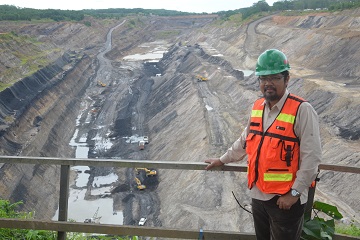IPB Lecturer Implemented Soil Reclamation of Abandoned Mine Land to be the Productive Land

Mining operations are governed by a series of regulations that have been passed by the Indonesian Ministry of Energy and Mineral Resources, Ministry of Forestry, and Ministry of Environment. Among other things, these regulations spell out how concession lands need to be rehabilitated following the cessation of mining operations. While, a small number of companies comply with these environmental regulations, a much larger number fail to meet their regulatory obligations entirely. This situation is having very detrimental environmental and social consequences in the region, as tens of thousands of hectares of mined land are simply abandoned with little, if any, rehabilitation. The problem of post mining land in Indonesia is quite difficult to solve. Post-mining land is considered marginal land that can’t be utilized. One of the reasons for the poor quality of post-mining rehabilitation is the lack of technical capacity. However, if everyone is just blaming, the post-mining land will be abandoned and unused. Most coal mine companies, particularly the small and medium sized ones, lack knowledge about best-practices, even though there are some very good examples of successful mine rehabilitation in East Kalimantan.
Dr. Ir. Irdika Mansur, MFor Sc is the faculty member of the Department of Silviculture of the Faculty of Forestry of Bogor Agricultural University (FAHUTAN IPB) who concerns on the reclamation of post-mining land. Various studies on the reclamation of post-mining land have been performed by the faculty member of IPB who was born in Manokwari. In 1995, together with other faculty members of the Forest Management Department, particularly the Sylvicultural Study, he has started to develop methods to restore the post-mining land to be rehabilitated again.
"At that first time the seedlings utilized were sengon (Albizia chinensis) and acacia (Acacia mangium), because it is spread abundantly. Both types of seedlings have rizobium and mycorrhiza so it can adapt in the land, "said Dr. Irdika who is currently the Director of SEAMEO BIOTROP.
Furthermore, in the 2000s, he tried to integrate superior local trees species that have a long life span and many woody perennials (such as Meranti, Eboni and Ulin) with fast-growing plant species (such as sengon and acacia). Currently, he explained, it has become a Ministerial Regulation that 40 percent of crops grown on post-mining land should come from the local superior seedlings.
Dr Irdika said that the involvement of communities around the post-mining location is really required, their social participation are really important for the successful implementation of such forest reclamation program. Of course, the government or NGO must provide some training courses on rehabilitation activity. For example, they are trained to collect ebony from the forest, seeded and then bought by the company.
"Mine reclamation is the process of restoring land that has been mined to a natural or economically usable state. Although the process of mine reclamation occurs once mining is completed, the planning of mine reclamation activities occurs prior to a mine being permitted or started. The utilization of superior local seedlings species for the reclamation of mine for post-mining land has been going on. Of course we are talking for the legal mining companies," he added.
He added that reforestation of post-mining land is currently being transformed into more productive. Conservation and reclamation efforts to ensure continued beneficial use of land resources are essential. Reclamation is the process by which derelict or highly degraded lands are returned to productivity, and by which some measures of biotic function and productivity is restored. Good planning and environmental management will minimize the impacts of mining on the environment and will help in preserving eco-diversity. Initially acacia is used as a fast-growing shelter tree, then another type that has the survival characteristics almost similar to acacia, it is eucalyptus. Eucalyptus essential oil has various medicinal properties; it is commonly used in cold remedies and insecticides but its potential benefits are varied. Grandis Eucalyptus trees take less than 4 years to reach market maturity. Production leaves at least 10 tons per hectare. Usually this eucalyptus plant is combined with nuts. "The species which initially “cost center” become revenue-generating profit centers," he said.
"This did not implement those research programs alone, but together with his students he supervises in a longer period of time. As to produce such the most reliable results it should be supported by various research program which are related to one another," said Dr. Irdika who completed his undergraduate program at the Faculty of Forestry of IPB; his Master degree program at University of Canterbury, New Zealand; and completing his PhD degree program at the University of Kent, England. (Wied)



